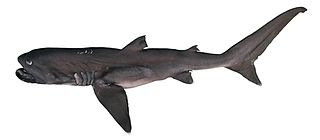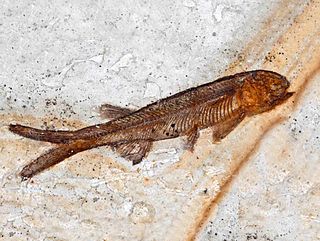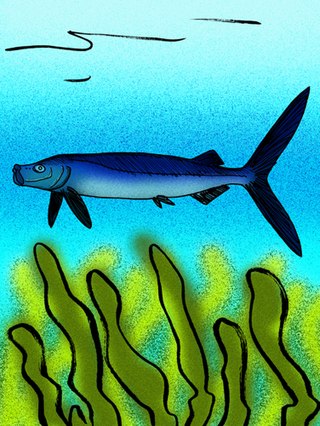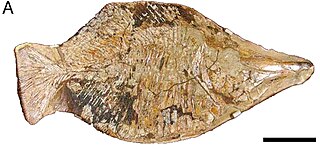
Megachasma is a genus of mackerel sharks. It is usually considered to be the sole genus in the distinct family Megachasmidae, though suggestion has been made that it may belong in the family Cetorhinidae, of which the basking shark is currently the sole extant member. Megachasma is known from a single living species, Megachasma pelagios.

Apsopelix is an extinct genus of ray-finned fish that existed about 95-80 million years ago in the shallow waters of the Western Interior Seaway, Hudson Seaway, England, France, and Japan.
Wakinosaurus is a genus of theropod dinosaur from the Early Cretaceous (Valanginian-Barremian) Sengoku Formation of Kyushu, Japan. The genus is a tooth taxon, based solely on the middle section of a single tooth.

Diplomystus is an extinct genus of freshwater clupeomorph fish distantly related to modern-day extant herrings, alewives, and sardines. The genus was first named and described by Edward Drinker Cope in 1877. There are seven species of Diplomystus: D. dentatus, D. birdii, D. dubetreiti, D. shengliensis, D. kokuraensis, D. primotinus, and D. altiformis.

Axelrodichthys is an extinct genus of mawsoniid coelacanth from the Cretaceous of Africa, North and South America, and Europe. Several species are known, the remains of which were discovered in the Lower Cretaceous (Aptian-Albian) of Brazil, North Africa, and possibly Mexico, as well as in the Upper Cretaceous of Morocco (Cenomanian), Madagascar and France. The Axelrodichthys of the Lower Cretaceous frequented both brackish and coastal marine waters while the most recent species lived exclusively in fresh waters. The French specimens are the last known fresh water coelacanths. Most of the species of this genus reached 1 metre to 2 metres in length. Axelrodichthys was named in 1986 by John G. Maisey in honor of the American ichthyologist Herbert R. Axelrod.

Mawsonia is an extinct genus of prehistoric coelacanth fish. It is amongst the largest of all coelacanths, with one quadrate specimen possibly belonging to an individual measuring 5.3 metres in length. It lived in freshwater and brackish environments from the late Jurassic to the mid-Cretaceous of South America, eastern North America, and Africa. Mawsonia was first described by British paleontologist Arthur Smith Woodward in 1907.

Mawsoniidae is an extinct family of prehistoric coelacanth fishes which lived during the Triassic to Cretaceous periods. Members of the family are distinguished from their sister group, the Latimeriidae by the presence of ossified ribs, a coarse rugose texture on the dermatocranium and cheek bones, the absence of the suboperculum and the spiracular, and reduction or loss of the descending process of the supratemporal. Mawsoniids are known from North America, Europe, South America, Africa, Madagascar and Asia. Unlike Latimeriidae, which are exclusively marine, Mawsoniidae were also native to freshwater and brackish environments. Mawsoniids represent among the youngest known coelacanths, with the youngest known remains of the freshwater genus Axelrodichthys from France and an indeterminate marine species from Morocco being from the final stage of the Cretaceous, the Maastrichtian, roughly equivalent in age to the youngest known fossils of latimeriids. Species of Mawsonia and Trachymetopon are known to have exceeded 5 metres in length, making them among the largest known bony fish to have ever existed.

Whiteia is an extinct genus of prehistoric coelacanth fish which lived during the Triassic period. It is named after Errol White.
The Meng-Yin or Mengyin Formation is a geological formation in Shandong, China, whose strata date back to the Berriasian and Valanginian stages of the Early Cretaceous.
Cladocyclus is an extinct genus of Ichthyodectidae. It was a predatory fish of about 1.20 metres (3.9 ft) in length, found in the Albian Romualdo and Crato Formations of the Araripe Basin in northeastern Brazil. The species Cladocyclus geddesi is known from the Winton Formation of Australia. Cladocyclus pankowskii, discovered in the Cenomanian Kem Kem Bed of Morocco in 2007, is reclassified to genus Aidachar.

Paralycoptera wui is an extinct species of basal osteoglossoid from Early Cretaceous freshwater environments of what is now China. P. wui was originally described as a lycopterid osteoglossomorph close to Lycoptera, though, later, on the basis of several well preserved specimens, Xu and Chang (2009) reassessed it as a basal osteoglossoid on the basis of better-preserved fossil material. Xu and Chang also synonymized the second described species, P. changi, as well as Tanolepis and Yungkangichthys hsitanensis, alleging that all of them were too similar to P. wui to merit separate generic or specific status, and that any anatomical differences between these taxa were due to taphonomic distortions of the specimens. In the same study, Xu and Chang also synonymized the related Japanese osteoglossomorph genus, Aokiichthys, on the basis of the two genera having an almost identical number of vertebrae, though they did not specify whether they were simply merging the two genera together, or if all the species within Aokiichthys were to be demoted as synonyms of P. wui.
Mesoclupea showchangensis is an extinct ichthyodectiform ray-finned fish that lived in freshwater environments in what is now China during the Early Cretaceous epoch. It differs from its sister genus, Chuhsiungichthys, primarily by having a more posteriorly-placed dorsal fin.
Chuhsiungichthys is an extinct genus of ichthyodectiform ray-finned fish that lived in freshwater environments in what is now Yunnan, China, and Kyushu, Japan, during the Cretaceous. It differs from its sister genus, Mesoclupea, primarily by having a comparatively more anteriorly-placed dorsal fin.
This list of fossil fishes described in 2013 is a list of new taxa of placoderms, fossil cartilaginous fishes and bony fishess of every kind that have been described during the year 2013. The list only includes taxa at the level of genus or species.

Lycopteridae is an extinct family of freshwater osteoglossomorph ray-finned fishes.
Masahiro Sato is a Japanese ice hockey player. He competed in the men's tournament at the 1964 Winter Olympics.

Wakinoichthys is a small freshwater fish from the Early Cretaceous of South Korea and Japan. Two species are currently known: W. aokii and W. robustus.

Araripelepidotes is a genus of ginglymodian fish.

Amakusaichthys is an extinct genus of ichthyodectiform fish which lived during the Late Cretaceous, known from only one species A. goshouraensis. Fossils are known from Kumamoto Prefecture in Japan.

Iemanja is a genus of pycnodontiform fish from the Early Cretaceous, described from Romualdo Member of Santana Group. This genus is known from only one species, I. palma. This fish is named after Yemọja, water spirit in Brazilian mythology. With length up to 60 cm (24 in), it is characterized by long snout that is probably used to feed from crevices of reef habitats.















